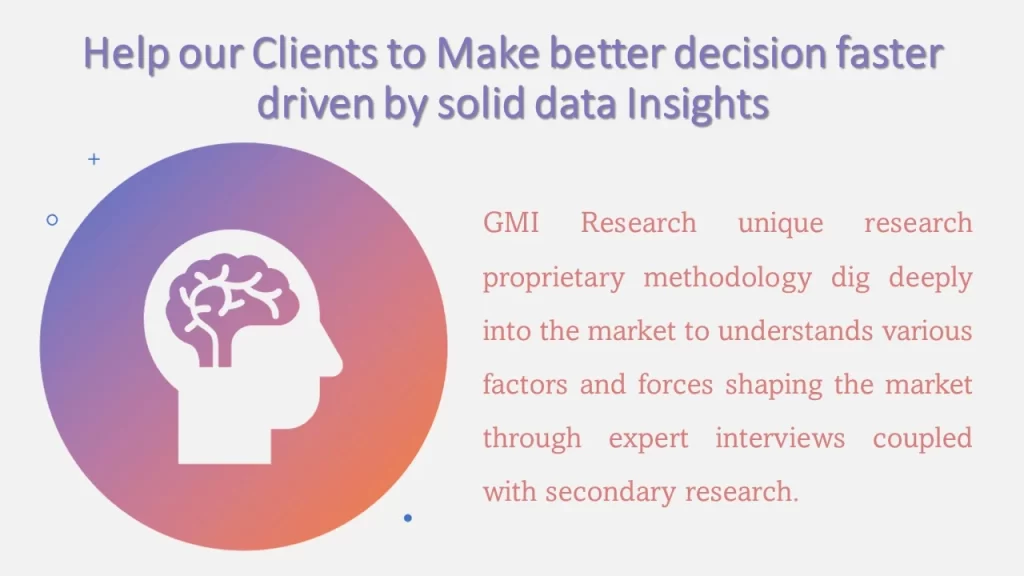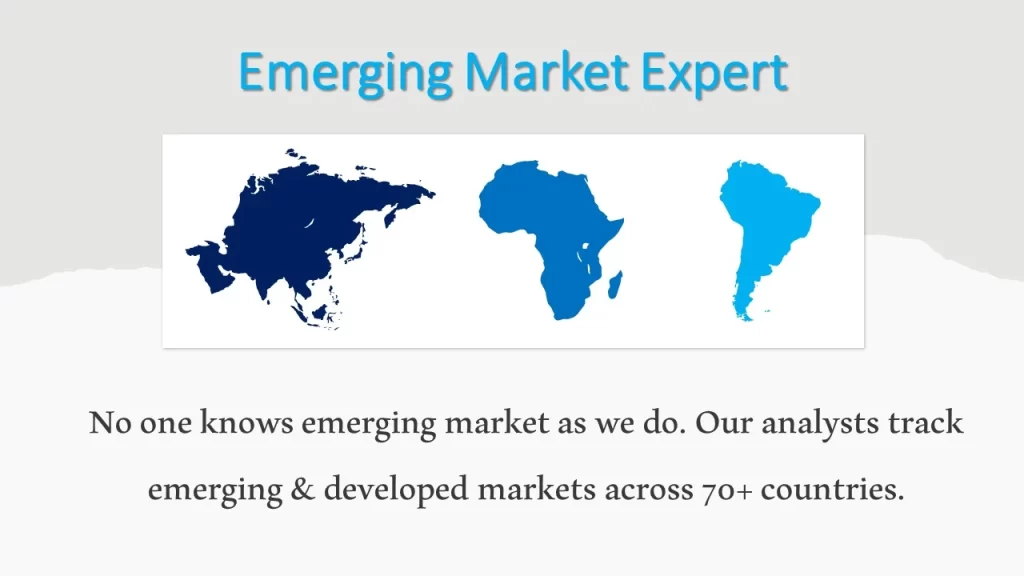Vertical Farming Market Size, Share, Trends and Growth Report – Global Opportunities & Forecast, 2024-2031
`Analysts at GMI Research estimates that the Vertical Farming Market size was worth USD 5.9 billion in 2023, and forecast to touch USD 29.5 billion in 2031, growing at a significant higher CAGR of 22.3% from 2024-2031.
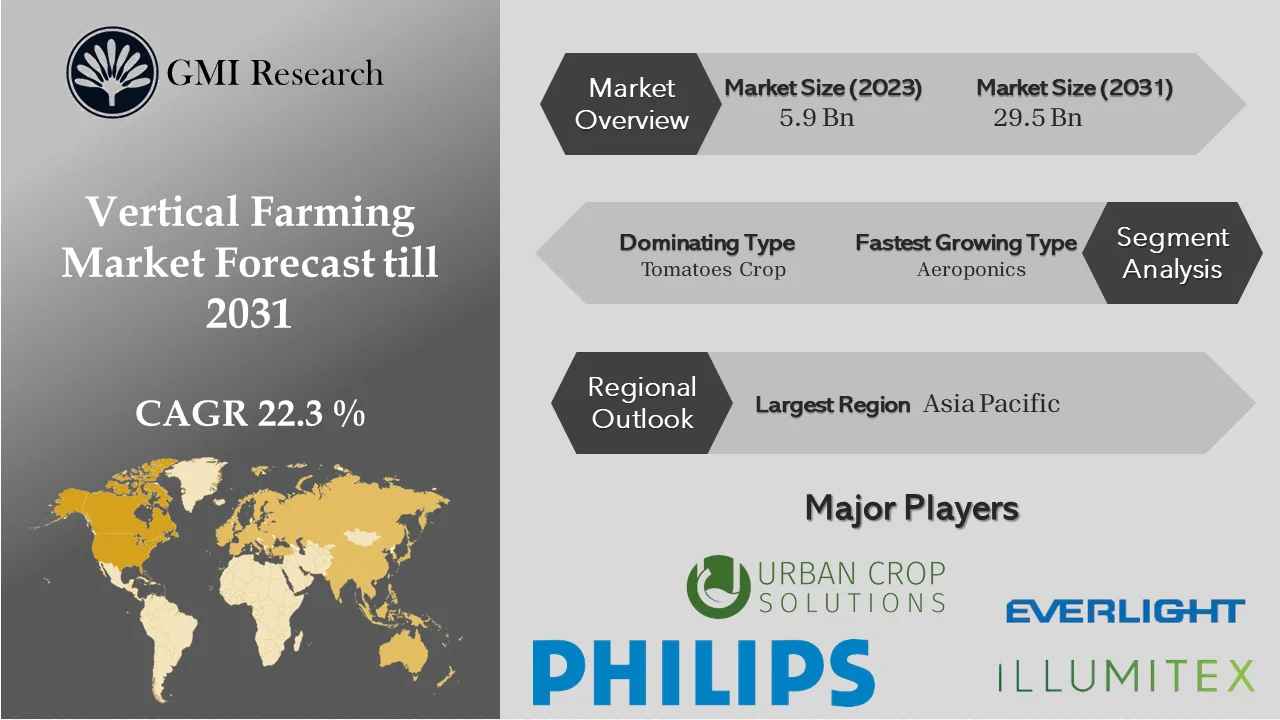
To have an edge over the competition by knowing the market dynamics and current trends of “Vertical Farming Market,” request for Sample Report here
Major Vertical Farming Market Drivers
Primary factors driving the global vertical farming market growth are increasing urbanization, rising health awareness among consumers, and a scarcity of farming land globally. Vertical agriculture minimises the agriculture environmental impact by decreasing water usage while maintaining rising crop yields. It removes the usage of chemicals and pesticides in crop cultivation and decreases the reliance on transportation. Vertical farms implement an organic approach throughout their entire process by significantly decreasing chemical usage. It adopts natural solutions, like using fish to introduce nutrient-rich waste for plants within the aquaponics growth system. Vertical farming is conducted in controlled surroundings to resist harmful pests and eradicate the need for pesticides. Avoiding burning fields or waste for pest control methods guarantees customers healthy and high-quality produce. This is anticipated to result in growth opportunities for market players in the vertical farming market.
In addition, the growing consumer preference for organic products, propelled by enhanced living standards and increase in disposable income, has led to the advancement of vertical farming, where organic farming practices are widely adopted. On a smaller scale, individuals are cultivating essential crops in their homes to secure pest-free food. The rise in health awareness and a preference for residue-free food has increased the adoption of advanced techniques such as aeroponics, hydroponics, and others. Although, vertical farming includes the cultivation of microgreens, and delivers a rich source of polyphenols-antioxidants known to decrease the risk of diseases such as heart disease, diabetes, Alzheimer’s disease, and other types of cancers.
The rapid growth of the vertical agriculture industry due to rapid innovations in technology is attracting both commercial as well as individual interest. Commercial growers are increasingly adopting high capital expenditure technologies including advanced hydroponic systems and electronic traceability systems. Moreover, growers are investing in LEDs and other innovative lighting solutions to minimize risks by thoroughly monitoring and adopting new technologies in the agricultural sector.
The rising demand for food to sustain the growing global population by 2050 has increased the vertical farming market size. Market investments drive development and technological innovations in this sector. The control over plant growth and minimal resource demands, including space and water, are driving the popularity of this technique, coupled with the food shortage in different segments of the globe. The lesser agricultural land, lack of water, and rise in need to address the demand of the rising population are estimated to propel vertical farming industry growth globally in the forecast period. Moreover, the food and agriculture industries facing continuous challenges in meeting the growing demand for food, worsened by decreasing accessibility of land resources for agriculture globally.
Similarly, the world is shifting towards a water crisis that is anticipated to worsen with climate changes impacting the food system. Vertical farms emerge as a solution to address challenges arising from water scarcity and limited arable land. Vertical farming technology regulates environmental conditions and increases water retention possibilities. With decreased evaporation, less water is lost into the atmosphere, lowering the pressure on farmers to constantly look for freshwater supplies. Therefore, due to all these factors the need arises to explore alternatives to conventional agriculture. Vertical farms have emerged as a resourceful solution for cultivating crops with both high quality and quantity. The vertical farming market research expected to rise in water crisis globally, including in countries such as India, Saudi Arabia, Jordan, Israel, and several others, and is predicted to foster the adoption of vertical farms in these regions.
While conventional farming accesses light, space, water, land, and carbon dioxide, these variables come with a high supply cost for vertical farms. Vertical farming employs artificial light, and spending for air cooling, heating to maintain optimal temperatures, precision monitoring, and relevant software are also part of the investment. Likewise, specific structures need to be erected for nutrient distribution and providing a platform for crop growth in vertical farms, making maintenance and resource supply relatively expensive.
Whereas integration of artificial intelligence and robotics in vertical farms drives market growth because these automated models allow monitoring the development of green plants from irrigation to garnering. Across the vertical farms, robots help move one plant to another place whereas, AI applications aid in managing light, water, and temperature needed for plants to grow. The global vertical farming market analysis predicts that the market players are investing in these technologies to enhance nutrients and crop health leading to result in different market growth opportunities in the forecast period.
Do you want to know more about the Research process and detailed Methodology, Request Research Methodology of this report
Building-based vertical farms dominated the market size in the global market, by structure
Building-based vertical farm structures have become popular in the vertical farming market due to their versatility which allows establishments in any location, to address weather and climate conditions. These structures are especially well-suited for regions facing challenges in traditional farming, such as deserts or urban. In addition, the effectiveness of building-based vertical farms is increasing the usage of resources including space, energy, and water through vertical stacking to accomplish higher and developed yields within a smaller field.
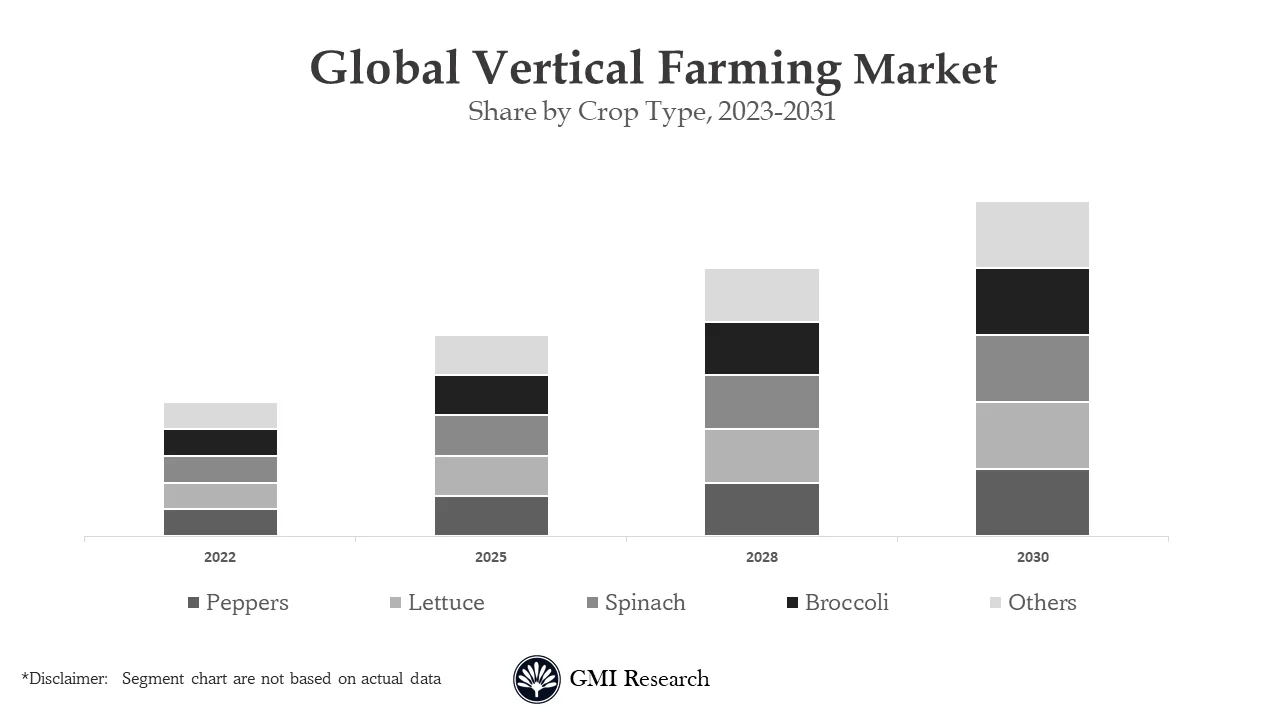
Lighting exhibited the largest revenue share in the global market, by components
The widespread usage of LED lighting in vertical farms has increased because of personalized benefits to the precise requirements of indoor agriculture. LED lights offer control over the power intensity and spectrum, enabling farmers to personalize lighting conditions for a variety of plants, resulting in driving growth and increased yields. Moreover, LED lights demonstrate high energy efficiency, consuming significantly less electricity compared to traditional lighting sources. Their longer lifespan contributes to decreased maintenance costs. In addition, the lower heat emissions from LED lights decrease the risk of heat-associated breakdown of plants and introduce a more attractive working surrounding for farmers. The advantages of the versatility of LED lighting are preferred choices in vertical farm operators and are important in the expansion and accomplishment of this development method of farming.
Hydroponics techniques are predicted to be the fastest-growing growth by mechanism in the global market
Hydroponics is a soil-less cultivation technique that depends on nutrients and water to offer a highly effective method for growing food. Its demand for less water and space compared to traditional farming methods makes it a favorable choice. Moreover, hydroponics allows for year-round production of food which was unaffected by climatic conditions. Commercial growers are especially drawn to hydroponics for its multitude of advantages of vertical farming. Firstly, it improved efficiency by minimizing space and water demands. Secondly, it empowers growers with higher control over the hydroponic system’s growing environment. Lastly, it fosters eco-friendly atmospheres compared to traditional farming practices. These benefits establish hydroponics as the preferred method for commercial growers involved in vertical farming.
In case, any of your pain points areas are not covered in the current scope of this report, Request for Customization here
By Region, North America dominated the largest market in the global vertical farming market
In the North American region, the U.S. is predicted to registered market growth due to rising concerns about food safety and nutrients. The increased demand for fresh, organic, and high-protein food presents a positive impact on the advancement of vertical farms across Canada, and the U.S. Additionally, different initiatives by the government to sustain the eco-friendly environment and decrease the usage of chemical pesticides are predicted to enhance the North America vertical farming market. Also, the players in the region are investing in automated systems and LED lights to personalize the crop yield environment resulting the different growth opportunities in North America.
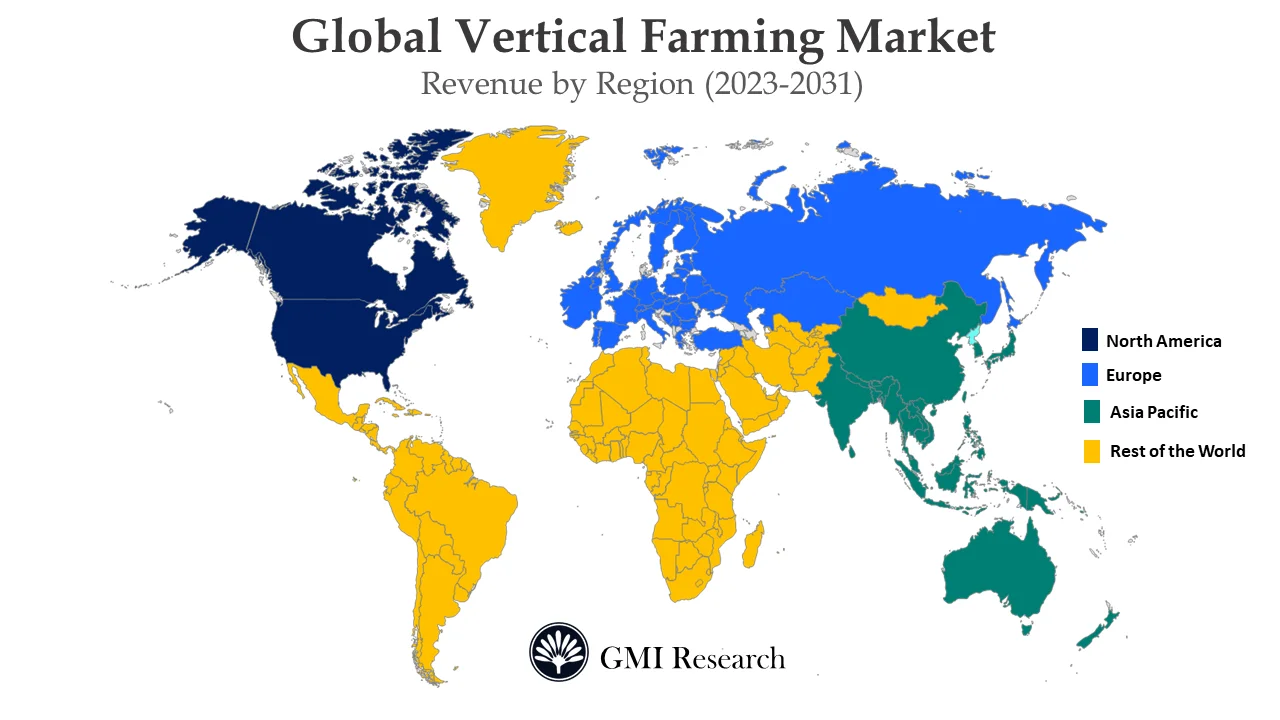
Top Market Players
Various notable players operating in the market include Koninklijke Philips N.V., Sky Greens, AeroFarms, EVERLIGHT, Illumitex, Agrilution, Green Sense Farms Holdings, Inc., Urban Crop Solutions, AmHydro, and Vertical Farm Systems, among others.
Key Developments:
-
- In 2023, AeroFarms announced an expansion nationally with Amazon Fresh to address the rising customer requirements for their flavorful, delicious, and fresh microgreens.
- In 2023, OSRAM joined hands with Revolution Microelectronics to strengthen its position in the market.
- In 2023, Realty Income collaborated with Plenty Unlimited Inc. to assist in the advancements of Plenty’s interior vertical farms with an investment of USD 1 billion.
- In 2022, Freight Farms partnered with The University of Arizona Biosphere 2 to experience new manners of developing food in environmental difficulties threatening the international food system.
- In 2022, Signify acquired Fluence to reinforce its position in North America and agriculture lighting growth platform.
- In 2020, Urban Crop Solutions collaborated with CropKing to integrate the extensive hydroponic experience of CropKing with the enhanced-quality controlled environment technology in the vertical farming of Urban Crop Solutions.
- In 2019, Illumitex launched NeoPARTM XO for vertical farming systems. This LED platform brings the advantages of the company’s horticulturist-curated artificial-intelligent machine-learning FarmVision AI to the difficult task of vertical farming.
Segments covered in the Report:
The Global Vertical Farming Market has been segmented on the basis of Growth Mechanism, Structure, Crops Type and Components. Based on the Growth Mechanism, the market is segmented into Hydroponics, Aeroponics, Aquaponics. Based on the Structure, the market is segmented into Shipping Container-based Vertical Farms, Building-based Vertical Farms. Based on the Crops Type, the market is segmented into Tomato, Lettuce, Berries and Pepper, Leafy Vegetables, Microgreens, Cucumber, Other Crop Types. Based on the Components, the market is segmented into Sensors, Lighting, Climate Control, Other Hydroponic Components.
For detailed scope of the “Vertical Farming Market” report request a Sample Copy of the report
|
Report Coverage |
Details |
| Market Revenues (2023) |
USD 5.9 billion |
| Market Base Year |
2023 |
| Market Forecast Period |
2024-2031 |
| Base Year & Forecast Units |
Revenues (USD Billion) |
| Market Segment | By Growth Mechanism, By Structure, By Crop Type, By Components, By Region |
| Regional Coverage | Asia Pacific, Europe, North America, and RoW |
| Companies Profiled | Koninklijke Philips N.V., Sky Greens, AeroFarms, EVERLIGHT, Illumitex, Agrilution, Green Sense Farms Holdings, Inc., Urban Crop Solutions, AmHydro, and Vertical Farm Systems among others; a total of 10 companies covered |
| 25% Free Customization Available | We will customize this report up to 25% as a free customization to address our client’s specific requirements |
Market Segmentation
Global Vertical Farming Market by Growth Mechanism
-
- Aeroponics
- Hydroponics
- Aquaponics
Global Vertical Farming Market by Structure
-
- Building-based Vertical Farms
- Shipping Container-based
- Vertical Farms
Global Vertical Farming Market by Crop Type
-
- Tomato
- Berries
- Lettuce and Leafy Vegetables
- Pepper
- Cucumber
- Microgreens
- Other Crop Types
Global Vertical Farming Market by Components
-
- Lighting
- Climate Control
- Sensors
- Other Hydroponic Components
Global Vertical Farming Market by Region
-
-
North America Vertical Farming Market (Option 1: As a part of the free 25% customization)
- By Growth Mechanism
- By Structure
- By Crop Type
- By Components
- US Market All-Up
- Canada Market All-Up
-
Europe Vertical Farming Market (Option 2: As a part of the free 25% Customization)
- By Growth Mechanism
- By Structure
- By Crop Type
- By Components
- UK Market All-Up
- Germany Market All-Up
- France Market All-Up
- Spain Market All-Up
- Rest of Europe Market All-Up
-
Asia-Pacific Vertical Farming Market (Option 3: As a part of the free 25% Customization)
- By Growth Mechanism
- By Structure
- By Crop Type
- By Components
- China Market All-Up
- India Market All-Up
- Japan Market All-Up
- Rest of APAC Market All-Up
-
RoW Vertical Farming Market (Option 4: As a part of the free 25% Customization)
- By Growth Mechanism
- By Structure
- By Crop Type
- By Components
- Brazil Market All-Up
- South Africa Market All-Up
- Saudi Arabia Market All-Up
- UAE Market All-Up
- Rest of world (remaining countries of the LAMEA region) Market All-Up
-
Global Vertical Farming Leading Market Players (Option 5: As a part of the free 25% Customization – Profiles of 5 Additional Companies of your Choice)
-
- Koninklijke Philips N.V.
- Sky Greens
- AeroFarms
- EVERLIGHT
- Illumitex
- Agrilution
- Green Sense Farms Holdings, Inc.
- Urban Crop Solutions
- AmHydro
- Vertical Farm Systems
Frequently Asked Question About This Report
Vertical Farming Market [UP1032A-00-0620]
The various crop types in the vertical farming market Tomato, Lettuce, Berries and Pepper, Leafy Vegetables, Microgreens, Cucumber, Other Crop Types.
The major factors driving the Vertical Farming Market includes the inclination of the consumers towards organic products, a decrease in the arable land, and the increasing demand for high-quality land.
Various notable players operating over the vertical farming market include Koninklijke Philips N.V., Sky Greens, AeroFarms, EVERLIGHT, Illumitex, Agrilution, Green Sense Farms Holdings, Inc., Urban Crop Solutions, AmHydro, and Vertical Farm Systems, among others.
Vertical Farming Market is predicted to grow at 22.3% CAGR during the forecast period.
Related Reports
- Published Date: Jan-2024
- Report Format: Excel/PPT
- Report Code: UP1032A-00-0620
Licensing Options
Single-User License:
The report is used by the purchaser (One Individual) only
Multi-User License:Report is shared with maximum 5 users (employees) including the purchaser of the purchasing corporation only
Corporate License:
Report is shared with unlimited user (employees) of the purchasing corporation only
The report is used by the purchaser (One Individual) only
Multi-User License:Report is shared with maximum 5 users (employees) including the purchaser of the purchasing corporation only
Corporate License:
Report is shared with unlimited user (employees) of the purchasing corporation only
Vertical Farming Market Size, Share, Trends and Growth Report – Global Opportunities & Forecast, 2024-2031
$ 4,499.00 – $ 6,649.00
Why GMI Research

